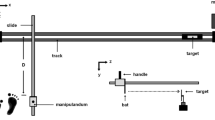Abstract
We examined the effect of exploring redundant solutions during practice in enhancing the ability to flexibly use them to achieve a task goal. Three groups used different degrees of path redundancy to perform a virtual interception task in which they attempted to hit a stationary target by moving around a stationary obstacle. The low-variability group always practiced with the same position of the obstacle on all trials. The medium-variability and high-variability groups practiced with the obstacle in different positions within a range of 1 and 2 cm respectively. After eight blocks of practice, all participants were transferred to two tests: (a) a fixed obstacle test where the condition was the same as that practiced by the low-variability group, and (b) a variable obstacle test where the condition was the same as that practiced by the high-variability group. Results showed that the low-variability group had the most accurate performance both in the fixed obstacle and the variable obstacle test. The low-variability group showed the least path variability during the fixed obstacle test but was also able to adapt to the different positions of the obstacle during the variable obstacle test. It appears that flexibility in interceptive tasks is emergent from learning a particular task-relevant parameter related to the target location.





Similar content being viewed by others
References
Arutyunyan GA, Gurfinkel VS, Mirskii ML (1969) Organization of movements on execution by man of an exact postural task. Biophysics 14:1162–1167
Battig WF (1972) Intra-task interference as a source of facilitation in transfer and retention. In: Thompson RF, Voss JF (eds) Topics in learning and performance. Academic Press, New York, pp 131–159
Berkinblit MB, Feldman AG, Fukson OJ (1986) Adaptability of innate motor patterns and motor control mechanisms. Behav Brain Sci 9:585–638
Bernstein NA (1967) The co-ordination and regulation of movements. Pergamon Press, Oxford
Bootsma RJ, van Wieringen PC (1990) Timing an attacking forehand in table tennis. J Exp Psychol Hum Percept Perform 16:21–29
Corcos DM, Jaric S, Gottlieb GL (1996) Electromyographic analysis of performance enhancement. In: Zelaznik HN (ed) Advances in motor learning and control. Human Kinetics, Champaign, pp 123–153
Darling WG, Cooke JD (1987) Changes in the variability of movement trajectories with practice. J Mot Behav 19:291–309
Darling WG, Cooke JD (1988) Kinematic variability of grasp movements as a function of practice and movement speed. Exp Brain Res 73:225–235
Diedrichsen J (2007) Optimal task-dependent changes of bimanual feedback control and adaptation. Curr Biol 17:1675–1679
Domkin D, Laczko J, Jaric S, Johansson H, Latash ML (2002) Structure of joint variability in bimanual pointing tasks. Exp Brain Res 143:11–23
Dugas C, Marteniuk RG (1989) Strategy and learning effects on perturbed movements: an electromyographic and kinematic study. Behav Brain Res 35:181–193
Feldman AG (1966) Functional tuning of the nervous system with control of movement or maintenance of a steady posture: II. Controllable parameters of the muscle. Biophysics 11:565–578
Feldman AG, Latash ML (2005) Testing hypotheses and the advancement of science: recent attempts to falsify the equilibrium-point hypothesis. Exp Brain Res 161:91–103
Feldman AG, Levin MF (1995) The origin and use of positional frames of reference in motor control. Behav Brain Sci 18:723–744
Fukson OJ, Berkinblit MB, Feldman AG (1980) The spinal frog takes into account the scheme of its body during the wiping reflex. Science 209:1261–1263
Georgopoulos AP, Kalaska JF, Massey JT (1981) Spatial trajectories and reaction times of aimed movements: effects of practice, uncertainty and change in target location. J Neurophysiol 46:725–743
Guthrie ER (1935) The psychology of learning. Harper and Row, New York
Henry FM (1968) Specificity vs. generality in learning motor skill. In: Brown RC, Kenyon GS (eds) Classical studies on physical activity. Prentice Hall, New Jersey, pp 328–331
Jaric S, Latash ML (1999) Learning a pointing task with a kinematically redundant limb: emerging synergies and patterns of final position variability. Hum Mov Sci 18:819–838
Kelso JAS, Holt KG (1980) Exploring a vibratory systems analysis of human movement production. J Neurophysiol 43:1183–1196
Kugler PN, Kelso JAS, Turvey MT (1980) On the concept of coordinative structures as dissipative structures: I. Theoretical lines of convergence. In: Stelmach GE, Requin K (eds) Tutorials in motor behavior. North-Holland, Amsterdam, pp 3–47
Latash ML, Scholz JP, Schöner G (2002) Motor control strategies revealed in the structure of motor variability. Exerc Sport Sci Rev 20:26–31
Lee TD, Magill RA (1983) The locus of contextual interference in motor-skill acquisition. J Exp Psychol Learn Mem Cognit 9:730–746
Lee TD, Swanson LR, Hall AL (1991) What is repeated in a repetition? Effects of practice conditions on motor skill acquisition. Phys Ther 71:150–156
Proteau L (1992) On the specificity of learning and the role of visual information for movement control. In: Proteau L, Elliott D (eds) Vision and motor control. North-Holland, Amsterdam, pp 67–103
Schmidt RA (1975) A schema theory of discrete motor skill learning. Psychol Rev 82:225–260
Scholz JP, Schöner G (1999) The uncontrolled manifold concept: identifying control variables for a functional task. Exp Brain Res 126:289–306
Schöner G (1995) Recent developments and problems in human movement science and their conceptual implications. Ecol Psychol 7:291–314
Shea JB, Morgan RL (1979) Contextual interference effects on the acquisition, retention, and transfer of a motor skill. J Exp Psychol Hum Learn Mem 5:179–187
Shea JB, Zimny ST (1983) Context effects in memory and learning movement information. In: Magill RA (ed) Memory and control of action. Elsevier, Amsterdam, pp 345–366
Todorov E, Jordan MI (2002) Optimal feedback control as a theory of motor coordination. Nat Neurosci 5:1226–1235
Yang JF, Scholz JP (2005) Learning a throwing task is associated with differential changes in the use of motor abundance. Exp Brain Res 163:137–158
Acknowledgment
We thank Tim Benner for providing software assistance with data collection. We also thank two anonymous reviewers for comments on an earlier version of this manuscript.
Author information
Authors and Affiliations
Corresponding author
Rights and permissions
About this article
Cite this article
Ranganathan, R., Newell, K.M. Emergent flexibility in motor learning. Exp Brain Res 202, 755–764 (2010). https://doi.org/10.1007/s00221-010-2177-7
Received:
Accepted:
Published:
Issue Date:
DOI: https://doi.org/10.1007/s00221-010-2177-7




